Until this point, we’ve discussed organelles and structures that are common to both plants and animals. Now we’re going to look at several structures that are not found in all eukaryotic cells. Because plants are rooted in the ground, unable to move, they have several special needs beyond those of animals. In particular, they can’t outrun predators or outmaneuver their competitors to get more food. If they need more light, they have few options beyond simply growing larger or taller. And to resist plant-
One structure that helps plants achieve these goals is the cell wall, which surrounds the plasma membrane. The cell wall is made largely from long fibers of a polysaccharide called cellulose. Note that although animal cells do not have cell walls, some non-
In plants, cell wall production can be a multistage process. Initially, when the cell is still growing, a primary cell wall is laid down, along with some glue that helps adjacent cells adhere to each other. Sometime later in life, a secondary cell wall is laid down. This secondary cell wall usually contains a complex molecule called lignin, which gives the wall much of its strength and rigidity. Oddly, this strength remains even after the plant cell dies—
The cell wall is nearly 100 times thicker than the plasma membrane. The tremendous structural strength it confers on plant cells enables some plants to grow several hundred feet tall and provides some protection from insects and other animals that might eat the plant. Cell walls also help to make plants more water-

Surprisingly, despite its great strength, the cell wall does not completely seal off plant cells from one another. Rather, it is porous, allowing water and solutes to reach the plasma membrane. Additionally, the cells in most plants have anywhere from 1,000 to 100,000 microscopic tube-
125
TAKE-HOME MESSAGE 3.20
The cell wall is an organelle found in plants (and in some other non-
List three functions of a plant’s cell wall.
A plant’s cell wall provides structural strength to the cell, makes the cell more water resistant, and provides some protection from insects and other animals.